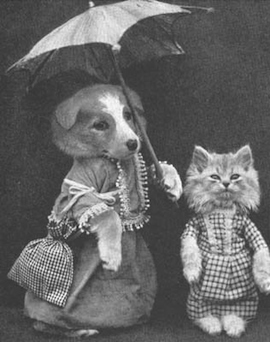Submitted by Emily Lederman on Wed, 10/15/2014 - 21:53

from buzzfeed.com
In his 2010 text, Developing Animals: Wildlife and Early American Photography, Matthew Brower considers the constructed nature of wildlife photography and what it tells us about historical understandings of human-animal relations. Brower is the curator of the University of Toronto Art Centre and a lecturer in museum studies in the Faculty of Information at the University of Toronto. Beginning with an analysis of early American photographs of taxidermy, his text examines the practice of “camera hunting” in the nineteenth century, the invention of the photographic blind and Abbott Thayer’s use of photographs to make arguments about animal coloration and camouflage. Brower argues that examining these photographic practices illustrates how they construct a particular narrative of the relationship between animals and humans. Brower suggests that photos of perceived “wild animals” are staged to tell a particular story about the historical constitution of the animal and human-animal interaction.